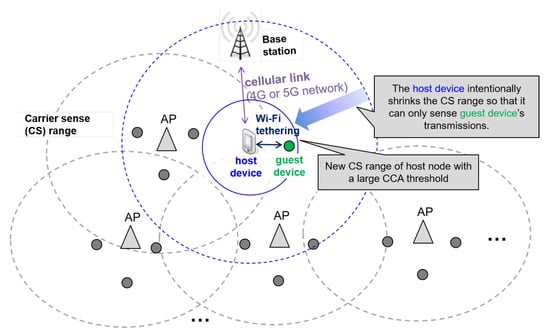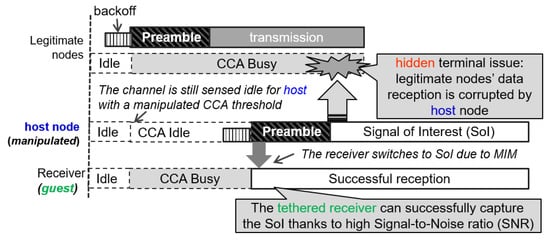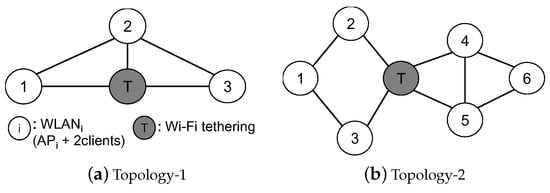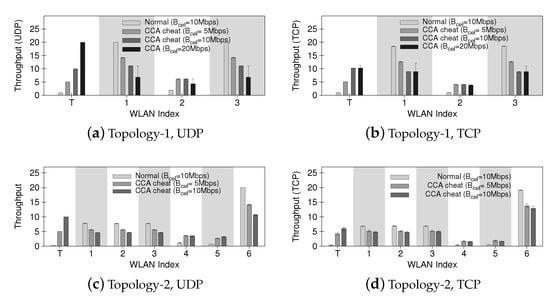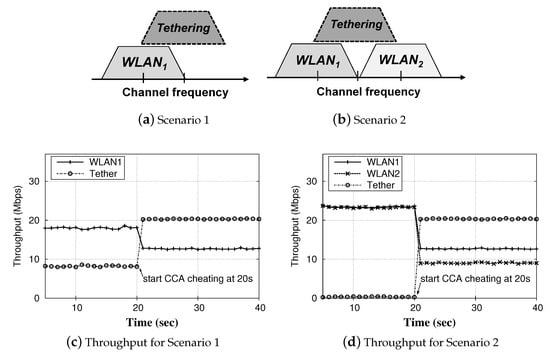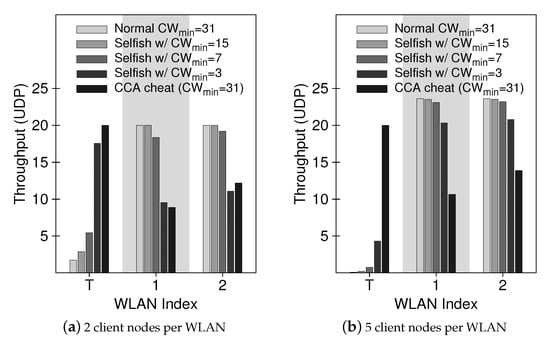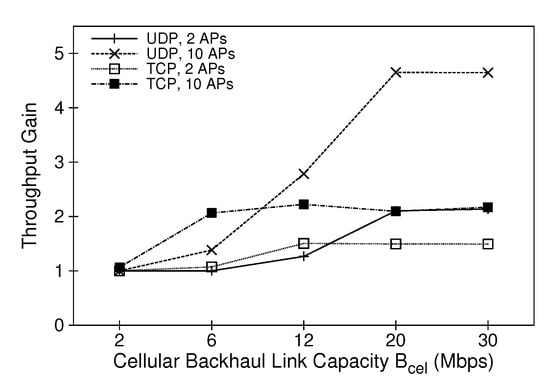Abstract
As Bring Your Own Device (BYOD) policy has become widely accepted in the enterprise, anyone with a mobile device that supports Wi-Fi tethering can provide an active wireless Internet connection to other devices without restriction from network administrators. Despite the potential benefits of Wi-Fi tethering, it raises new security issues. The open source nature of mobile operating systems (e.g., Google Android or OpenWrt) can be easily manipulated by selfish users to provide an unfair advantage throughput performance to their tethered devices. The unauthorized tethering can interfere with nearby well-planned access points (APs) within Wi-Fi networks, which results in serious performance problems. In this paper, we first conduct an extensive evaluation study and demonstrate that the abuse of Wi-Fi tethering that adjusts the clear channel access parameters has strong adverse effects in Wi-Fi networks, while providing the manipulated device a high throughput gain. Subsequently, an online detection scheme diagnoses the network condition and detects selfish tethering devices by passively exploiting the packet loss information of on-going transmissions. Our evaluation results show that the proposed method accurately distinguishes the manipulated tethering behavior from other types of misbehavior, including the hidden node problem.
1. Introduction
Bring Your Own Device (BYOD), which refers to a policy of permitting employees to bring their personal devices to the workplace and to use those devices by connecting them to the internal network, has become a common practice in the enterprise [1]. As of 2016, six out of 10 companies had a BYOD-friendly policy in the workplace and 87% of companies rely on their employees having access to business apps from their personal devices, according to Syntonic’s recent survey [2]. Although it offers benefits, such as increased employee productivity and greater employee satisfaction, adopting a BYOD policy poses several potential security holes to the organization, since BYOD devices can bypass the managed network without the controls in place. One of the most relevant wireless technologies is Wi-Fi tethering, which uses a mobile device (e.g., a smartphone or a tablet) as a Wi-Fi hotspot and provides a wireless Internet connectivity to other devices [3].
While Wi-Fi tethering allows for mobile users to go online almost anywhere, even on-the-move, the ease of setting up a tethered Wi-Fi hotspot and the open source nature of mobile Operating Systems (OSes) can pose serious performance problems to well-planned Wi-Fi networks, such as enterprise and campus networks [4]. Because the tethered Wi-Fi hotspot can potentially open up the network with an arbitrary channel number without restriction from the network administrator, it may interfere with nearby well-planned access points (APs) and cause unpredictable performance degradation, e.g., availability and throughput. Even worse, the open and customizable nature of mobile OSes, such as Google Android and OpenWrt, can be further abused by selfish users in order to provide their tethering an unfair advantage in throughput performance. For example, by rooting or jailbreaking mobile OSes, the channel access functions of Wi-Fi protocol, i.e., IEEE 802.11, can be manipulated “selfishly”, at the cost of other nearby well-behaving Wi-Fi device performance. Note that the newest IEEE 802.11ax standard (aka Wi-Fi 6) [5] has been investigating adaptive carrier sensing (CS), which is also known as dynamic sensitivity control (DSC), in order to improve the spatial reuse in dense deployments [6]. This implies that the parameters of Wi-Fi tethering, particularly Clear Channel Assessment (CCA) thresholds are readily tunable and can be manipulated in order to gain an unfair advantage in throughput performance. Thus, it is essential to design an efficient mechanism in order to detect unauthorized and misconfigured Wi-Fi tethering.
In this paper, we observe the network throughput behavior in a multi-AP environment in the presence of a tethering device, and study the impact of selfish tethering on other users’ throughput performance. We show that the abuse of Wi-Fi tethering that adjusts the CCA threshold has strong adverse effects in Wi-Fi networks, while providing the tethered device a high throughput gain. Our evaluation results reveal that the symptoms of selfish tethering resembles that of the well-known hidden node problem—they both result in a high frame transmission error rate. However, the main difference is that the frame losses at legitimate nodes that are caused by the selfish tethering cannot be easily resolved by the RTS/CTS mechanism, because the selfish nodes may not recognize or sense the RTS/CTS frames due to their manipulated CCA thresholds. Therefore, it is imperative to design a detection mechanism that can identify the root cause of the throughput degradation and pinpoint the selfish node in the network.
To this end, we present an online detection mechanism, called CUBIA, which can accurately detect misbehaving Wi-Fi tethering nodes in a multi-AP Wi-Fi network. CUBIA runs at each AP and passively monitors the ongoing data traffic to detect any abnormal changes caused by target selfish tethering. In particular, it monitors any noticeable increase in frame loss rate and identifies the root cause of the frame loss, e.g., selfish tethering or hidden node problem. For this, we formulate the selfish tethering detection problem as a hypothesis testing problem and employs a modified CUSUM algorithm. We evaluate CUBIA with an in-depth simulation in various wireless environments, and our evaluation results show high detection accuracy. To best of our knowledge, this is the first paper to consider the problem of detecting selfishly misconfigured Wi-Fi tethering devices in a multi-AP network.
Contributions. This paper makes several contributions, as follows.
- We observe that concurrent transmission mechanisms, e.g., PHY capture or message-in-message (MIM), can be abused by selfish nodes, and study the impact of the selfish Wi-Fi tethering behavior on the throughput performance of other nearby well-behaving nodes.
- We propose a selfish misbehavior detection mechanism, called CUBIA, which can accurately identify the cause of frame losses and detect selfish behavior under strict detection latency requirements.
- We design a two-step detection process using an online change detection algorithm, i.e., CUSUM, which is based on passive monitoring of frame loss rates at multiple APs. We also study the impact of detection thresholds on detection latency/accuracy performance.
- We perform extensive simulation-based evaluation for various network conditions. Our evaluation results show that CUBIA can promptly detect selfish behavior with high accuracy in realistic wireless environments.
Organization. The remainder of paper is organized as follows. Section 2 describes the system model and illustrates the impact of selfish manipulation of the CCA threshold (CST) on the throughput performance in multi-AP environments. Section 3 identifies the unique features of selfish tethering and proposes CUBIA that accurately detects the selfish behavior. Section 4 presents the evaluation results. We summarize related research work in Section 5 and Section 6 concludes the paper.
3. A Proposed Online Detection Algorithm
The symptoms of selfish tethering resembles those of the well-known hidden node problem—they both result in excessive frame loss of nearby legitimate APs. Thus, the successful detection of selfish misbehavior depends largely on a AP’s ability to identify the root cause of its frame losses. Note that in 802.11 Wi-Fi, there are four main causes of frame losses: (i) PHY-layer link quality degradation, (ii) MAC-layer collision, (iii) hidden nodes, and (iv) selfish misbehavior (e.g., manipulation of the CCA thresholds).
Fortunately, selfish tethering exhibits unique features that can facilitate distinguishing the selfish carrier sensing of a tethering host from other causes of frame losses, especially from the hidden node problem. The main difference is that the frame losses at legitimate nodes that are caused by selfish tethering cannot be easily resolved by the RTS/CTS mechanism. This is because the selfish nodes may not recognize the RTS/CTS frames, owing to their manipulated CCA thresholds (i.e., their short sensing ranges) or RTS/CTS frames can be intentionally ignored by the selfish nodes.
Based on this observation, we propose a simple, yet efficient online detection algorithm, called CUBIA (CUsum-Based Interference inference with Adaptive RTS/CTS) that can accurately distinguish selfish behavior with CCA manipulation from other types of network problems, such as severe network congestion (i.e., collisions) and the hidden node problem. CUBIA operates at each AP and diagnoses the network condition by passively monitoring the ongoing traffic with its client nodes. Specifically, if CUBIA detects severe and persistent frame transmission failures, then it employs the RTS/CTS exchange before each data transmission to eliminate the possibility of the hidden node problem. For this, CUBIA employs the CUSUM (CUmulative SUM) algorithm [19] to quantify the duration of the frame losses. CUSUM algorithm suits our needs, because it is simple and light-weight and has been widely used for the detection of state changes. In the following, we describe the detailed procedure of the detection mechanism whlie using the CUSUM algorithm.
CUBIA monitors the frame error rate (FER) for every m transmissions to detect any abrupt changes in network condition, which could indicate the possibility of selfish tethering nodes. Let denote the frame error rate for the k-th measurement period at the AP, given by , where denotes the number of transmission failures. Subsequently, we calculate the average error probability by a moving average to reflect the network dynamics as:
We define the CUSUM change detection filter of the AP, as:
where v is a drift parameter, which is a filter design parameter. v is configured differently, according to the value of , as:
where and denote the first alarm threshold for asymmetric carrier sensing and the detection (second) alarm threshold for inferring selfish carrier sensing, respectively. CUBIA issues the first alarm to the AP when . Subsequently, CUBIA adaptively activates the RTS/CTS exchange mechanism and continues to track the change detection with in Equations (2) and (3).
Note that the first alarm can be caused by a sudden severe MAC layer congestion or a hidden node problem. However, in such a case, the magnitude of tends to decrease with RTC/CTS frames, because the collisions are filtered out [20] and the hidden terminal problem are mitigated with RTS/CTS exchange. The frame error rate decreases accordingly.
Conversely, if the first alarm is caused by the selfish carrier sensing problem, a frame transmission following successful RTS/CTS exchanges will be interfered with and, hence, even with RTS/CTS, the magnitude of would continue to increase, even beyond . Recall that, under a normal condition, the PHY-layer link quality is stable and has a certain upper bound , namely, the target FER, which is guaranteed by the underlying rate-adaptation scheme that adjusts the modulation schemes to meet the target FER (e.g., = 0.05 is used in the evaluation). For example, practical rate adaptations [21] adjust the modulation schemes to meet the target FER (frame error rate) and, thus, guarantee the average FER performance to be maintained around the target value.
Consequently, the AP issues a detection alarm to the central controller in the network (see Figure 1) if , which may trigger a follow-up action at the controller level to solve the selfish carrier sensing problem within the managed network.
Remark. Although the focus of this paper is to propose an AP-level detection mechanism, it is important to cope with the selfish misbehavior detected within the network at the system level. Here, we briefly discuss how the controller determines when to take follow-up actions to cope with the selfish misbehavior detected within the network. In typical managed Wi-Fi networks, the information that is obtained at APs is integrated on the controller. Subsequently, the controller utilizes the information to improve the detection accuracy. When the selfish tethering is present, the majority of nearby APs will be likely to experience the similar severe packet errors simultaneously. Consequently, the victim APs send the detection alarm to the controller at the same time. By exploiting the spatial and temporal correlation in those alarms, the controller identifies the root of the problem more effectively and accurately. For example, if a certain condition is satisfied, then the controller can take various follow-up actions, which can be (i) localizing the rogue interfering node [22], and (ii) remedying victim APs (e.g., interference-aware channel reassignment), etc. However, the detailed follow-up actions are beyond the scope of this paper.
4. Performance Evaluation
We now evaluate the performance of the proposed detection algorithm via simulation. We have implemented the proposed CUBIA in a network simulator [12].
4.1. Simulation Setup
In the simulation, the multi-AP network is deployed in a m area, where five APs with 10 client nodes are randomly generated (the link distance between a client and its AP is randomly selected from the range of 1–35 m); this represents a densely-populated configuration fully covering the entire area. The transmission range and carrier sensing range of legitimate nodes are set to 75 m, and 150 m, respectively. A selfish tethering pair is placed at the center of the area, whose link distance and carrier sensing are set to 1 m and 10 m, respectively. Table 2 lists the parameter values that were used in the simulation study.

Table 2.
Parameters used in performance evaluation.
The performance is evaluated in terms of detection accuracy and time for TCP and UDP protocols. We consider a downlink scenario, where each AP transmits frames to its client nodes.
4.2. Detection Performance
4.2.1. Accuracy of Frame Loss Differentiation
To demonstrate the efficacy of CUBIA in distinguishing the selfish carrier sensing problem, we consider three testing scenarios: (i) selfish carrier sensing, (ii) hidden node problem, and (iii) collisions.
Figure 9 shows the temporal behavior of CUSUM change detection filter for the three testing scenarios. Figure 9a plots the results of CUBIA over time for the case of selfish problem in the topology that is depicted in Figure 9b. We can observe that the detection filters of APs in the interference range continue to increase, where the selfish node starts transmissions at 5 s.
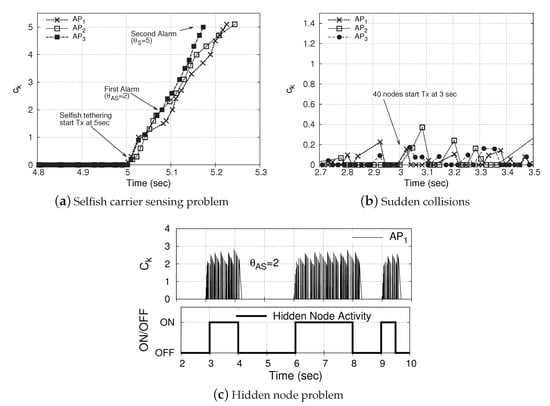
Figure 9.
The dynamics of CUBIA toward three difference types of frame losses.
Figure 9b,c show CUBIA’s ability of filtering the collisions and the hidden node problem, respectively. To simulate an abrupt change in the network state, initially, 10 AP–clients pairs are considered until an additional 40 nodes are abruptly activated at 3 s. Figure 9b demonstrates that CUBIA effectively filters out the MAC-layer collisions. We generated ON/OFF traffic on a hidden node in order to simulate the impact of the hidden node problem, as illustrated in Figure 9c. In the figure, we can see that the detection filter of CUBIA promptly reacts to the hidden node, increasing above , but the value of remains low and does not exceed . This is because the effect of a hidden node is mitigated by adaptive RTS/CTS changes, thus imparting a negative drift to the detection filter.
Overall, our proposed scheme CUBIA accurately distinguishes the selfish misbehavior with CCA manipulation from collisions and the hidden node problem.
4.2.2. Detection Performance
We now evaluate the detection performance of CUBIA. It is important to meet the detectability requirements, such as the maximum allowed latency of detection. In this simulation study, we assume that the maximum allowed latency of detection is 2 s, which is, if the selfish misbehavior is not detected within 2 s, then we consider this case as a mis-detection. In practice, the detection latency requirement can be adjusted based on specific needs/conditions of the network and protocol stack. For example, an extended exposure to selfish carrier sensing can cause TCP congestion control and fast recovery algorithms to kick in, which make it very difficult to recover the throughput performance. There also exists a tradeoff between the detection sensitivity and false-alarm rate, which is part of our future work. We run the simulation 150 times for each set of tests with various backhaul link capacities of selfish tethering and alarm thresholds.
Table 3 and Table 4 show the detection results for UDP and TCP protocols, respectively. We can observe that our scheme can detect the selfish behavior with high backhaul capacity with very high accuracy. Note that implies the intensity of selfish behavior, because, the larger the , the more outstanding packets the selfish node can transmit, which causes severe interference, as observed in Section 2.2. However, the results imply that, in many cases, the detection decision takes more than 2 s with low selfish intensity, i.e., small . This is because the impact of such a moderately selfish node on the network performance is not significant, i.e., the selfish node only achieves a small throughput gain over the legitimate nodes. Consequently, the moderate selfish node is not immediately detectable by CUBIA within 2 s, since it takes more samples for the AP to accurately detect such selfish nodes. Figure 10 shows the average throughput degradation ratio of well-behaving nodes due to the selfish node for various values of selfish intensity (i.e., ). The figure implies that a higher selfish intensity incurs a severer interference on well-behaving nodes. The throughput degradation can be ignored when the backhaul link capacity of the selfish node is small.

Table 3.
Detection performance for the UDP protocol.

Table 4.
Detection performance for the TCP protocol.
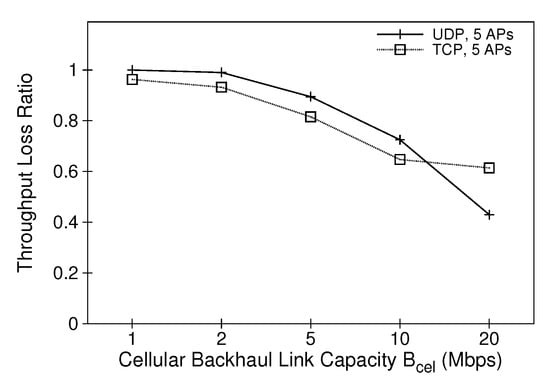
Figure 10.
Impact of selfish intensity on the performance of well-behaving nodes.
We next evaluate the impact of the backhaul link capacity of selfish tethering on the detection performance for = 2, 5, 10, and 20 Mbps. Figure 11 shows the cumulative distribution of detection time under various . The results indicate that more aggressive selfish behavior, i.e., higher , is detected more quickly by CUBIA for both TCP and UDP protocols. This indicates that CUBIA can quickly detect aggressive selfish behaviors, which is a very important design requirement for any good detection scheme since such an aggressive behavior can seriously degrade the performance of well-behaving nodes.
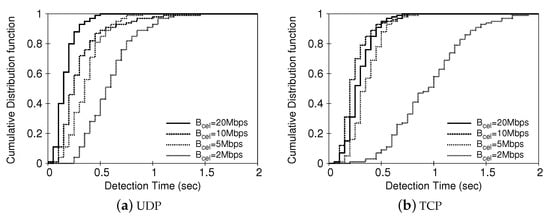
Figure 11.
Impact of on detection time.
Finally, we study the impact of alarm thresholds, i.e., and , on the detection time. Figure 12 depicts the distribution of detection time for three different values of the first alarm threshold . It is straightforward that the use of a smaller value of may issue the first alarm too frequently and may incur an unnecessary overhead for RTS/CTS exchange, which results in performance degradation. Meanwhile, the results show that it takes less detection time with a smaller .
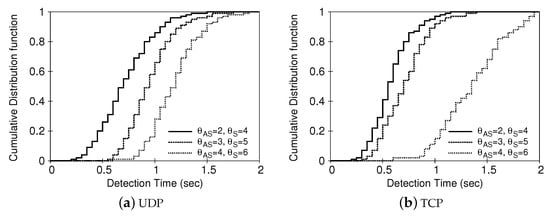
Figure 12.
Impact of the first alarm threshold on detection time for UDP and TCP protocols with = 20 Mbps.
Similarly, the impact of the second alarm threshold can be seen in Figure 13. The figure compares the detection time for different values of with the given = 3. We can see that the detection time increases proportional to . However, there is a tradeoff between the false alarm ratio and the detection time according to the choice of . For example, in case of the temporal behavior of the detection filter in Figure 9c, the use of a small value of can cause false alarms (if is set to be less than , it would issue several false alarms.) although it can reduce the detection time unless the hidden node exists. Thus, it is recommended to use a value of larger than , in order to avoid false alarms, although it might take more time to detect.
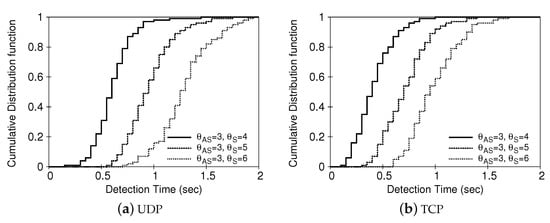
Figure 13.
Impact of the second alarm threshold for the given = 3 on detection time with = 20 Mbps.
5. Related Work
Selfish and malicious misbehavior in wireless networks has been extensively studied under various scenarios in different communication layers. The majority of previous work has concentrated on detecting or punishing MAC-layer misbehavior [18,23,24,25]. In [18], Kyasanur and Vaidya studied the MAC-layer misbehavior of selecting always small backoff values rather than random selection, and showed that such selfish misbehavior can seriously degrade the network performance. Raya et al. [23] investigated multiple misbehavior policies in 802.11 MAC protocol, including backoff manipulations, and presented a detection framework, called DOMINO, which considers all possible strategies jointly and improves the detection accuracy. Several statistic-based frameworks for detecting misbehavior also have been introduced [24,25]. Their common detection approach is to measure the inter-arrival time of target stations in terms of the number of backoff slots and verify whether the backoff time of the stations follows a legitimate pattern or not. The authors in [26] proposed a non-parametric CUSUM test in order to detect real-time selfish misbehavior in 802.11 networks. The problem of selfish misbehavior has also been addressed in several different layers and perspectives, including the coexistence between LTE and Wi-Fi systems in unlicensed bands [27], the emerging machine-to-machine (M2M) communications [28], relay networks [29], routing layers [30,31], multi-channel protocols [32], and game theory-based behaviors [28,33]. The problem of misbehavior using the unfair coexistence between LTE-LAA and Wi-Fi system is relatively new and unexplored in the literature. In [27], the problem of detecting misbehaving of LTE/Wi-Fi has been addressed. The authors of [34] presented a new model for analyzing the throughput performance for Wi-Fi and LTE-LAA coexistence, which can act as a baseline model to be exploited to distinguish misbehaving coexistence from the legitimate behavior. In [35], the authors have identified the effect of an 802.11 node’s selfish behavior by manipulating the CCA threshold. They have shown that the selfish behavior can achieve higher throughput than other well-behaving nodes that are based on a game-theoretical model. The authors in [36,37] addressed the selfish carrier sense problem in 802.11 Wi-Fi networks. The authors performed experimentation on a real-world testbed and showed that such selfish behaviors can cause extremely unfair allocations of the wireless medium. In [37], the detection of misbehavior in dense Wi-Fi networks has been addressed and a detection method that is based on a statistics has been presented. However, none of these studies considered the problem of the selfish problem exploiting Wi-Fi tethering environments.
6. Conclusions and Future Work
In this paper, we present CUBIA, a novel Wi-Fi tethering misbehavior detection mechanism that can accurately detect selfish behavior, e.g., manipulating CCA threshold, via AP-level collaboration in multi-AP network environments. We show that the benefits of MIM can be fully exploited and abused further by a selfish tethering node via CCA manipulation combined with its short link-distance. We also observe that the consequence of the selfish tethering behavior resembles that of the hidden node problem, but selfish tethering nodes tend to ignore the RTS/CTS mechanism. CUBIA employs a CUSUM algorithm for the online detection of abnormal network behavior and inject RTS/CTS frames to avoid mis-diagnosing the hidden node problem as a selfish tethering. Our simulation-based evaluation results show that CUBIA accurately distinguishes the selfish tethering behavior from other types of misbehavior including the hidden node problem.
In the future, we would like to extend our work to pinpoint and localize the selfish node based on the cooperation among APs. It would also be interesting to study effective system-level follow-up actions against selfish tethering misbehavior, such as jamming-resilient dynamic channel re-assignment.
Funding
This work was supported in part by the National Research Foundation of Korea(NRF) grant funded by the Korea government (MSIT) (No. NRF-2020R1A2C1013308) and the Gachon University research fund of 2019 (Grant No. GCU-2019-0776).
Conflicts of Interest
The authors declare no conflict of interest.
Abbreviations
The following abbreviations are used in this manuscript:
| AP | Access Point |
| CCA | Clear channel assessment |
| CST | Carrier sensing threshold |
| CUSUM | cumulative sum |
| FER | frame error rate |
| MIM | Message-In-Message |
| SIR | signal to interference ratio |
| SoI | the Signal of Interest |
| WLAN | Wireless LAN |
| SIR threshold for modulation scheme m | |
| MIM threshold for modulation scheme m | |
| target frame error rate |
References
- Bitglass. 2018 BYOD Security Report. Available online: https://pages.bitglass.com/MissionImpossibleSecuringBYOD_LP.html (accessed on 1 August 2020).
- Syntonic. Syntonic 2016 Employer Report: BYOD Usage in the Enterprise. Available online: https://syntonic.com/wp-content/uploads/2016/09/Syntonic-2016-BYOD-Usage-in-the-Enterprise.pdf (accessed on 1 August 2020).
- Hoffman, C.; Summerson, C. How to Tether Your Android Phone and Share Its Internet Connection with Other Devices. Available online: https://www.howtogeek.com/170302/the-htg-guide-to-tethering-your-android-phone/ (accessed on 1 August 2020).
- Doherty, J. Wireless and Mobile Device Security; Jones & Bartlett Publishers: Boston, MA, USA, 2015. [Google Scholar]
- Khorov, E.; Kiryanov, A.; Lyakhov, A.; Bianchi, G. A Tutorial on IEEE 802.11ax High Efficiency WLANs. IEEE Commun. Surv. Tutor. 2019, 21, 197–216. [Google Scholar] [CrossRef]
- Aijaz, A.; Kulkarni, P. On performance evaluation of dynamic sensitivity control techniques in next-generation wlans. IEEE Syst. J. 2019, 13, 1324–1327. [Google Scholar] [CrossRef]
- Wang, W.; Zhang, F.; Zhang, Q. Managing channel bonding with clear channel assessment in 802.11 networks. In Proceedings of the 2016 IEEE International Conference on Communications (ICC), Kuala Lumpur, Malaysia, 22–27 May 2016; pp. 1–6. [Google Scholar]
- Choi, J.; Shin, K.G. Out-of-band sensing with ZigBee for dynamic channel assignment in on-the-move hotspots. In Proceedings of the 2011 19th IEEE International Conference on Network Protocols, Vancouver, BC, Canada, 17–20 October 2011; pp. 216–225. [Google Scholar]
- Leentvaar, K.; Flint, J. The capture effect in FM receivers. IEEE Trans. Commun. 1976, 24, 531–539. [Google Scholar] [CrossRef]
- Lee, J.; Kim, W.; Lee, S.; Jo, D.; Ryu, J.; Kwon, T.T.; Choi, Y. An experimental study on the capture effect in 802.11a networks. In Proceedings of the Second ACM InternationalWorkshop onWireless Network Testbeds, Experimental Evaluation and Characterization, Montreal, QC, Canada, 9–14 September 2007; pp. 19–26. [Google Scholar]
- Manweiler, J.; Santhapuri, N.; Sen, S.; Choudhury, R.; Nelakuditi, S.; Munagala, K. Order matters: Transmission reordering in wireless networks. IEEE/ACM Trans. Netw. 2012, 20, 353–366. [Google Scholar] [CrossRef][Green Version]
- The Network Simulator-ns2. Available online: www.isi.edu/nsnam/ns (accessed on 3 September 2018).
- Wiggle: Wireless Geographic Logging Engine. Available online: http://www.wigle.net/ (accessed on 3 September 2018).
- Garetto, M.; Salonidis, T.; Knightly, E.W. Modeling per-flow throughput and capturing starvation in csma multi-hop wireless networks. IEEE/ACM Trans. Netw. 2008, 16, 864–877. [Google Scholar] [CrossRef]
- Choi, J.; Shin, K.G. QoS provisioning for large-scale multi-AP WLANs. Ad Hoc Netw. 2012, 10, 174–185. [Google Scholar] [CrossRef][Green Version]
- Zhang, X.; Shin, K.G. Adaptive subcarrier nulling: Enabling partial spectrum sharing in wireless lans. In Proceedings of the 2011 19th IEEE International Conference on Network Protocols, Vancouver, BC, Canada, 17–20 October 2011; pp. 311–320. [Google Scholar]
- Mishra, A.; Rozner, E.; Banerjee, S.; Arbaugh, W. Exploiting partially overlapping channels in wireless networks: Turning a peril into an advantage. In Proceedings of the 5th ACM SIGCOMM Conference on Internet Measurement, Berkeley, CA, USA, 19–21 October 2005; p. 29. [Google Scholar]
- Kyasanur, P.; Vaidya, N.H. Selfish MAC layer misbehavior in wireless networks. IEEE Trans. Mob. Comput. 2005, 4, 502–516. [Google Scholar] [CrossRef]
- Gustafsson, F. Adaptive Filtering and Change Detection; John Wiley & Sons, Ltd.: London, UK, 2000. [Google Scholar]
- Kim, J.; Kim, S.; Choi, S.; Qiao, D. CARA: Collision-aware rate adaptation for IEEE 802.11 WLANs. In Proceedings of the IEEE INFOCOM 2006, Barcelona, Spain, 23–29 April 2006; pp. 1–11. [Google Scholar]
- Jensen, T.; Kant, S.; Wehinger, J.; Fleury, B. Fast link adaptation for MIMO OFDM. IEEE Trans. Veh. Technol. 2000, 59, 3766–3778. [Google Scholar] [CrossRef]
- Joshi, K.; Hong, S.; Katti, S. PinPoint: Localizing interfering radios. In Proceedings of the 10th USENIX NSDI, Lombard, IL, USA, 2–5 April 2013; pp. 241–254. [Google Scholar]
- Raya, M.; Aad, I.; Hubaux, J.-P.; Fawal, A.E. DOMINO: Detecting MAC layer greedy behavior in IEEE 802.11 hotspots. IEEE Trans. Mob. Comput. 2006, 5, 1691–1705. [Google Scholar] [CrossRef]
- Radosavac, S.; Baras, J.; Koutsopoulos, I. A Framework for MAC Protocol Misbehavior Detection in Wireless Networks. In Proceedings of the WiSE05: 2005 ACM Workshop on Wireless Security (Co-Located with Mobicom 2005 Conference), Cologne, Germany, 2 September 2005; pp. 33–42. [Google Scholar]
- Toledo, A.; Wang, X. Robust Detection of Selfish Misbehavior in Wireless Networks. IEEE J. Sel. Areas Commun. 2007, 25, 1124–1134. [Google Scholar] [CrossRef]
- Tang, J.; Cheng, Y. Selfish Misbehavior Detection in 802.11 Based Wireless Networks: An Adaptive Approach Based on Markov Decision Process. In Proceedings of the IEEE INFOCOM, Turin, Italy, 14–19 April 2013; pp. 1357–1365. [Google Scholar]
- Samy, I.; Lazos, L.; Xiao, Y.; Li, M.; Krunz, M. LTE misbehavior detection in Wi-Fi/LTE coexistence under the LAA-LTE standard. In Proceedings of the 11th ACM Conference on Security & Privacy in Wireless and Mobile Networks (WiSec’18), Stockholm, Sweden, 18–20 June 2018; pp. 87–98. [Google Scholar]
- Liew, J.T.; Hashim, F.; Sali, A.; Rasid, A.; Cumanan, K. Performance Evaluation of Backoff Misbehaviour in IEEE 802.11ah Using Evolutionary Game Theory. In Proceedings of the 2019 IEEE 89th Vehicular Technology Conference (VTC2019-Spring), Kuala Lumpur, Malaysia, 28 April–1 May 2019; pp. 1–7. [Google Scholar]
- Szott, S.; Konorski, J. Selfish Attacks in Two-Hop IEEE 802.11 Relay Networks: Impact and Countermeasures. IEEE Wirel. Commun. Lett. 2018, 7, 658–661. [Google Scholar] [CrossRef]
- BenSalem, N.; Buttyan, L.; Hubaux, J.P.; Jakobsson, M. A Charging and Rewarding Scheme for Packet Forwarding in Multihop Cellular Networks. In Proceedings of the 4th ACM International Symposium on Mobile Ad Hoc Networking & Computing (MobiHoc), Annapolis, MD, USA, 1–3 June 2003; pp. 13–24. [Google Scholar]
- Pu, C.; Lim, S.; Chae, J.; Jung, B. Active detection in mitigating routing misbehavior for MANETs. Wirel. Netw. 2017, 25, 1669–1683. [Google Scholar] [CrossRef]
- Zhang, Y.; Lazos, L. Countering selfish misbehavior in multi-channel MAC protocols. In Proceedings of the IEEE INFOCOM, Turin, Italy, 14–19 April 2013; pp. 2787–2795. [Google Scholar]
- Akella, A.; Seshan, S.; Karp, R.; Shenker, S. Selfish Behavior and Stability of the Internet: A Game-Theoretic Analysis of TCP. In Proceedings of the ACM SIGCOMM, Pittsbugh, PA, USA, 19–23 August 2002; pp. 117–130. [Google Scholar]
- Gao, Y.; Roy, S. Achieving Proportional Fairness for LTE-LAA and Wi-Fi Coexistence in Unlicensed Spectrum. IEEE Trans. Wirel. Commun. 2020, 19, 3390–3404. [Google Scholar] [CrossRef]
- Yang, E.; Choi, J.; Lee, S. On selfish behavior using asymmetric carrier sensing in IEEE 802.11 wireless networks. In Proceedings of the 2008 33rd IEEE Conference on Local Computer Networks (LCN), Montreal, QC, Canada, 14–17 October 2008; pp. 527–529. [Google Scholar]
- Pelechrinis, K.; Yan, G.; Eidenbenz, S.; Krishnamurthy, S.V. Detecting Selfish Exploitation of Carrier Sensing in 802.11 Networks. In Proceedings of the IEEE INFOCOM, Rio de Janeiro, Brazil, 19–25 April 2009; pp. 657–665. [Google Scholar]
- Afaqui, M.; Brown, S.; Farrell, R. Detecting MAC Misbehavior of IEEE 802.11 Devices within Ultra Dense Wi-Fi Networks. In Proceedings of the 2018 25th International Conference on Telecommunications (ICT), St. Malo, France, 26–28 June 2018; pp. 213–219. [Google Scholar]
Publisher’s Note: MDPI stays neutral with regard to jurisdictional claims in published maps and institutional affiliations. |
© 2020 by the author. Licensee MDPI, Basel, Switzerland. This article is an open access article distributed under the terms and conditions of the Creative Commons Attribution (CC BY) license (http://creativecommons.org/licenses/by/4.0/).
